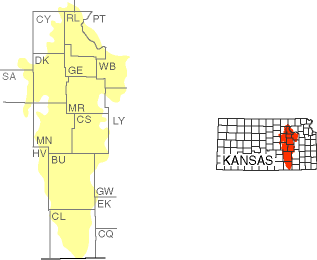Flint Hills

Despite differences of opinion about the exact boundaries, most geologists agree that the Flint Hills extend from Marshall County in the north to Cowley County in the south (across the state line in Oklahoma, they are known as the Osage Hills).

The Flint Hills were formed by the erosion of Permian-age limestones and shales. During the early part of the Permian Period (about 299 to 252 million years ago), shallow seas covered much of the state, as they did earlier in the Pennsylvanian Subperiod. Unlike the Pennsylvanian limestones found at the surface to the east, many of the limestones in the Flint Hills contain numerous bands of chert, or flint. Because chert is much less soluble than limestone, a clayey soil filled with cherty gravel was left behind after the limestone weathered away. The cherty gravel caps most of the region's hilltops, slowing their erosion.
Because the soil is cherty and thin (you don't have to dig deep to reach solid rock), the land is better suited for ranching than farming. As surrounding prairies were plowed up and planted in crops, the Flint Hills region remained largely unscathed. It is now the last sizable remnant of a tallgrass prairie that once stretched across a vast swath of North America.
Big and little bluestem, switch grass, and Indian grass are the main native grasses in the Flint Hills. Trees are rare, except along stream and river bottoms. Where streams have cut into chert-bearing limestone layers, their channels are narrow and boxlike, but where they have cut into weaker shales, their channels are wider with more gently sloping valleys.
The Tallgrass Prairie National Preserve in Chase County and the Konza Prairie southwest of Manhattan in Riley County are two excellent locations to experience the Flint Hills. Both have miles of hiking trails open to the public. Pillsbury Crossing Wildlife Area southwest of Manhattan provides access to a waterfall flowing over a limestone ledge on the south branch of Deep Creek. The Chase County Courthouse in Cottonwood Falls, one of the most unusual public buildings in Kansas, is just one of the many examples of buildings in the Flint Hills constructed from local limestones.